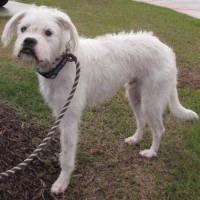 |
Boxerdoodle |
|
He is not recognized by the F.C.I. |
Origin |
Germany <> France -> U.S.A. | |
Translation |
Francis Vandersteen |
A brief presentation of the Boxerdoodle |
| The Boxerdoodle is a popular hybrid breed that's easy to train, friendly and good for families. Because there are three types of Poodle (toy, miniature and standard), the Boxerdoodle can be a small to large dog depending on the type of Poodle parent it has. These friendly dogs can measure between 25 and 63 centimeters in height and weigh between 5.5 and 32 kilos. They have thick, curly or wavy coats that are usually dark brown, but can also be shades of white, tan and black. Although this breed can live indoors or out, they are best suited to indoor living, especially the miniature and toy types. |
History of the Boxerdoodle |
| The Boxerdoodle is one of the most recent of the specific crossbreed dog breeds, and it's not known exactly when it was first introduced. Best guesses suggest that the breed appeared on the scene during the 2000s. |
A little of the Boxer |
||
| The Boxer was a descendant of the old fighting dogs in the high valleys of Tibet and is thought to be related to almost all Bulldog varieties. They also owe part of their lineage to the Dogue de Bordeaux of France and the Tibetan Mastiff. Another story is that German hunters were trying to create a new breed by mixing the Bulldog, Mastiff and Bullenbeisser in 1830. The breed was used to hunt large animals such as deer, wild boar and bear. The Boxer was also used as a bull baiter and in dog fighting before these events became illegal. However, today's Boxers have none of the aggression of the early Boxers. The Boxer is the 10th most popular dog breed in the USA and was registered with the American Kennel Club (AKC) in 1904. | ||
 |
||
| Standard of the Boxer | ||
A little of the Poodle |
||
| The history of the Poodle began in France in the 1500s and is one of the best-known dog breeds in the world. They come in three styles, which include standard, miniature and toy. This breed was originally developed as a water dog and their name comes from the German name for puddle, which is "pfudel". The Poodle is excellent for duck hunting and has also been used as a circus performer, service dog, guard, dog and guide dog. Their coats are usually cut for swimming if used for duck hunting with the hair left in puffs on the knees and tail for protection. However, many believe that these puffs of hair are more a matter of decoration than hunting. The Poodle is the 7th most popular breed in America and was registered in 1887. | ||
 |
||
| Standard of the Poodle |
Appearance of the Boxerdoodle |
| Because the Poodle is available in three different sizes, from toy to standard, the Boxerdoodle can come in a wide range of sizes from small to large. They are generally curly, or the hair may simply be wavy, but can be long or short. They are square and muscular with floppy ears, a long tail and a short muzzle like a Boxer. Boxerdoodles can come in almost any color, but are usually dark brown or maroon. With small feet and long legs, they are fast runners and excellent swimmers, which is probably why they are often used for duck hunting. |
Temperament of the Boxerdoodle |
| The Poodle in your Boxerdoodle has a sensitive side and you need to be careful when training them. The best way to train them is to reward them for good behavior, but don't be too indulgent or your dog could end up taking advantage of you. Boxerdoodles can also be stubborn, so you need to make sure they know who's boss. They love children but are best with older children. In addition, they need to be socialized early to get used to other animals. Their playful nature is well known, and they're full of amusing antics that will make you laugh. |
Needs and activities of the Boxerdoodle |
| Although the Boxerdoodle loves to exercise, it can be just as happy hanging around the house with you. However, for health reasons, you need to make sure your Boxerdoodle gets at least 45 minutes to an hour of brisk exercise a day. This breed loves to swim and hunt, so this type of sport is a good choice for your Boxerdoodle. Other exercise choices include walking, jogging, the dog park, retrieving and agility training. If your dog doesn't get enough exercise, he may have behavioral problems or act out due to boredom. So it's a good idea to establish a daily exercise routine to avoid these problems. |
Maintenance of the Boxerdoodle |
| With its luxurious coat, the Boxerdoodle should be carefully brushed with a wire brush and comb every other day. Many owners choose to have their Boxerdoodle professionally groomed every three to six months. Their fur can become quite matted if not properly cared for. In addition, their eyes and ears require special attention and should be checked and cleaned weekly. Their nails can be trimmed at home if necessary, or when you groom your dog. They can actually become a little smelly if not bathed regularly, but don't shampoo them too often or you'll deplete the oils they need to keep their skin and coat healthy. You should also brush your Boxerdoodle's teeth once or twice a week to avoid dental problems. |






 English (United Kingdom)
English (United Kingdom)